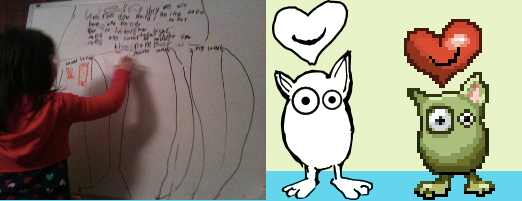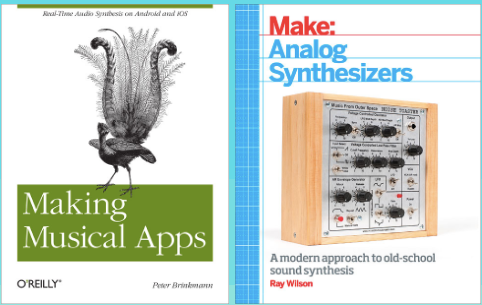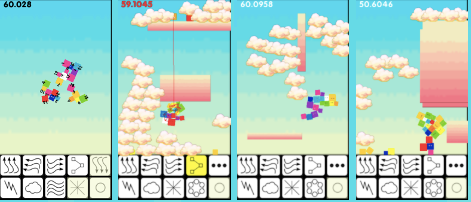Fluxly began in 2008 as a wizard duel game where you had to make your own game controller in hardware in order to play it. The first demo controllers were cigar boxes with pennies, an Arduino and a USB connection. It was originally written in Flash using the Box2d physics engine (the same one used by the original Angry Birds) and ran on a desktop computer.

There were about 20 different aspects of the game that you could control: gravity, wind, lightning, etc. The idea was that participants would use Arduino to make a controller (there was a Fluxly Arduino library), and whoever could make the best controller would have an edge in the game. It was pretty fun; we launched it at the first RI Maker Faire, Foo Fest, and a bunch of other events. It even got a mention in Boing Boing.
The original Fluxly character was based on a whiteboard drawing by my daughter Louise that I turned into a sketch. For the game Arley Rose Torsone turned it into lovely pixel art.

Arley and I and Brandon Edens began meeting on Tuesday afternoons to teach ourselves how to make apps. The first project we worked on was another Louise-inspired game called Space Wozzle, an episodic sci-fi collection of mini games riffing on classic arcade games. We made a few iterations but we realized the truth about making video games is that they have to be fun and they have to jell, and I'm afraid Space Wozzle ended up having too any moving parts.

Later, we used the same "meet every Tuesday for a year and see what happens" business model with Elliot Clapp and Shawn Greenlee to work on some musical apps. Elliot and I had just finished the first year of Fab Academy and had made a few hardware musical projects at that time, like the Fluxamasynth and the Fluxalodian. Meanwhile Shawn had taught a great three week workshop on Pure Data called the Pure Data Club, which was how I started learning the tool. Another happenstace was the release of Peter Brinkmann's libPd, which allows you to enbed Pure Data as a sound engine in embedded or mobile devices. Shawn, Elliot and I made about 6 libPd apps in a year, two of which we thought were interesting enough to launch in the app store: Noisemusick and DR-OM.

The Noisemusick app was based on a hardware kit I had made at AS220 that we used in Learn To Solder workshops.

After that I was at O'Reilly Media and Maker Media for a few years, during which I had the pleasure of working with Peter Brinkmann on a book about libPd called Making Musical Apps. I also worked with Ray Wilson on his book Make: Analog Synthesizers, which is when I spent more and more time exploring electronic musical instruments.

I made a bunch of little instruments and sonic appliances at this time, one of which was the Yak Shaver. The Yak Shaver was a resitive touch interface to a Pure Data patch that was inspired by the Rhythmicon. The Rhythmicon (below right) was essentially the world's first electronic drum machine, which Henry Cowell commissioned from Leon Theremin. It was optical and operated on spinning tone wheels; each key on the 12 note keyboard would play a pulsing tone at a multiple of the previous key. My Pure Data patch emulated this, but let you read in a WAV sound sample file and play it back at different multiples of tempo.

Since 2014 I've been at AS220 Industries, which is a Fab Lab, Printshop and Media Lab in Providence RI. It's a great place to make friends and meet interesting people. Fluxly is directly influenced by many members and coworkers at the Industries: Jacque Bidon's moire pattern books, Aisha Jandosova and Melita Morales' Maker Camp activities (mutant instruments, gear trains, and more moire!), Tycho Horan's risograph color experiments hanging next to my worktable, Chris Anderson's experiments with the Benjolin synthesizer we made in a workshop, and more. Singer Laurie Amat (and coordinator of the PVD Loop festival) is a frequent Industries visitor and offered testing, vocal recordings, and moral support.

All this background may seem tangential to Making Fluxly but it isn't. Looking back at the various projects on my hard drive I think I tried 3 different times over the years to turn the original Fluxly "make your own controller" wizard duel game into a mobile app. Each time I hit a couple of road blocks; the major one was how to make it fun as a one player game. There was also a technical limitation of the physics engine running on a mobile device; I found it could only handle a hundred or so objects (with my primitive coding) where I was imagining a larger play area with hundreds of objects.


The latest version of Fluxly finally started coming together when I thought about making the game more about the objects than about the characters. At first I was thinking it would be a physics puzzler with a soundtrack, but after hooking up the Yak Shaver Engine everything finally jelled and it became obvious that it should be a musical looper. Adding the physics interface to the Yak Shaver freed the instrument from its integer intervals and opened up room to explore randomness. Everything else seemed to fall into place because of the years of incremental influences and projects that had come before.
The 15 built-in samples may seem a little random, but each also has some background:
- A sample from Aisha's Banu Musa Music Box, a programmable cardboard xylophone with chimes made from the scrap of Larry Zargosky's geodesic domes.
- One of Laurie Amat's vocal snippets contributed for promotion of Modern Device's Reverbalizer.
- A bytebeat sample from the Modern Device Shempscape Bytebeat Shufflebox.
- A snippet from Chris Anderson's Benjolin playing.
- A recording of the Shopbot spindle as Hannah Liongoren works on a project n the fab lab.
- Another Laurie Amat sample.
- Geoff Griffin on bass in the intro to "Ask Me About Being a Bog Person".
- A classic public domain thunder sample.
- The introduction to "The Best Sauce is a Good Applesauce".
- A sample of the DROM app.
- A recording of the RISD Jacquard loom from a project with Jungil Hong.
- A bit of generative marimba music from the Fluxamasynth.
- A sample of the Noisemusick app.
- A recording from a Maker camp participant's mutant instrument.
- The background music from original Fluxly game.
Next: How the Software Works
 Fluxly
Fluxly
Discussions
Become a Hackaday.io Member
Create an account to leave a comment. Already have an account? Log In.